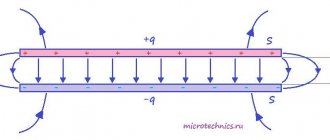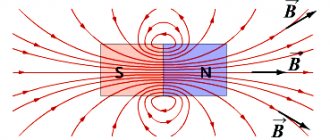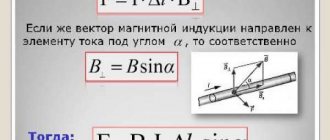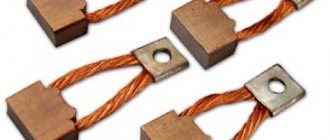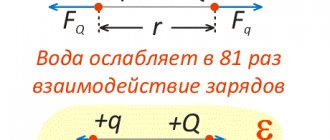Electromagnetic screens are widely used in industry. They serve to eliminate the harmful influence of some elements of an electrical device on others, to protect personnel and equipment from the effects of external fields that arise during the operation of other devices. “Quenching” of the external magnetic field is necessary when creating laboratories intended for setting up and testing highly sensitive equipment. It is also required in medicine and those fields of science where ultra-low induction fields are measured; to protect information during its transmission over cables.
Methods
Magnetic field shielding is a set of methods for reducing the strength of a constant or alternating field in a certain area of space. A magnetic field, unlike an electric one, cannot be completely weakened.
In industry, the greatest impact on the environment is caused by stray fields arising from the operation of transformers, permanent magnets, high-current installations and circuits. They can completely disrupt the normal operation of neighboring devices.
Most often, 2 protection methods are used:
- The use of screens made of superconducting or ferromagnetic materials. This is effective in the presence of a constant or low frequency magnetic field.
- Compensation method (quenching by eddy currents). Eddy currents are volumetric electric currents that arise in a conductor when the magnetic flux changes. This method shows the best results for high-frequency fields.
Diamagnetic.
Sometimes they mistakenly think that a diamagnetic material
. But this is not true. A diamagnetic material actually weakens the magnetic field. But it weakens the magnetic field only in the thickness of the diamagnetic itself, inside the diamagnetic. Because of this, many people mistakenly think that if one or both magnets are immured in a piece of diamagnetic material, then their attraction or repulsion will weaken.
But this is not a solution to the problem. Firstly, the field lines of one magnet will still reach another magnet, that is, the magnetic field only decreases in the thickness of the diamagnetic, but does not disappear completely. Secondly, if the magnets are immured in the thickness of the diamagnetic material, then we cannot move or rotate them relative to each other.
And if you just make a flat screen out of a diamagnetic material, then this screen will transmit a magnetic field through itself. Moreover, behind this screen the magnetic field will be exactly the same as if this diamagnetic screen did not exist at all.
This suggests that even magnets embedded in a diamagnetic material will not experience a weakening of each other’s magnetic field. In fact, where the walled magnet is located, there is simply no diamagnetic material directly in the volume of this magnet. And since there is no diamagnetic material where the walled magnet is located, it means that both walled magnets actually interact with each other in exactly the same way as if they were not walled up in the diamagnetic material. The diamagnetic material around these magnets is as useless as the flat diamagnetic shield between the magnets.
Principles
The principles of magnetic field shielding are based on the laws of magnetic field propagation in space. Accordingly, for each of the above methods they are as follows:
- If you place an inductor in a casing made of a ferromagnetic material, then the induction lines of the external magnetic field will pass along the walls of the protective shield, since it has less magnetic resistance compared to the space inside it. Those power lines that are induced by the coil itself are also almost all closed to the walls of the casing. For the best protection in this case, it is necessary to choose ferromagnetic materials that have high magnetic permeability. In practice, iron alloys are most often used. In order to increase the reliability of the screen, it is made thick-walled or assembled from several casings. The disadvantages of this design are its heaviness, bulkiness and deterioration of shielding in the presence of seams and cuts in the walls of the casing.
- With the second method, the weakening of the external magnetic field occurs as a result of the superposition of another field induced by ring eddy currents. Its direction is opposite to the induction lines of the first field. As the frequency increases, the attenuation will be more pronounced. For shielding in this case, plates in the form of a ring of conductors with low resistivity are used. Cylinder-shaped boxes made of copper or aluminum are most often used as screen-casings.
Bending of a superconductor by magnetic field lines
But this does not mean at all that if a superconducting screen is placed between two magnets, it will solve the problem. The fact is that the magnetic field lines of the magnet will go to another magnet, bypassing the superconductor screen. Therefore, a flat superconducting screen will only weaken the influence of magnets on each other.
This weakening of the interaction between the two magnets will depend on how much the length of the field line that connects the two magnets to each other has increased. The greater the length of the connecting field lines, the less interaction between two magnets with each other.
This is exactly the same effect as if you increase the distance between the magnets without any superconducting screen. If you increase the distance between magnets, then the lengths of the magnetic field lines also increase.
This means that in order to increase the lengths of the power lines that connect two magnets bypassing the superconducting screen, it is necessary to increase the dimensions of this flat screen both in length and width. This will lead to an increase in the lengths of bypass power lines. And the larger the dimensions of the flat screen compared to the distance between the magnets, the less interaction between the magnets becomes.
The interaction between the magnets completely disappears only when both dimensions of the flat superconducting screen become infinite. This is an analogue of the situation when magnets were separated to an infinitely large distance, and therefore the length of the magnetic field lines connecting them became infinite.
Theoretically, this, of course, completely solves the problem. But in practice we cannot make a superconducting flat screen of infinite dimensions. I would like to have such a solution that can be implemented in practice in the laboratory or in production. (We are no longer talking about everyday conditions, since it is impossible to make a superconductor in everyday life.)
Main characteristics
To describe the shielding process, 3 main characteristics are used:
- Equivalent magnetic field penetration depth. So let's continue. This indicator is used for the shielding effect of eddy currents. The lower its value, the higher the current flowing in the surface layers of the protective casing. Accordingly, the greater the magnetic field induced by it, which displaces the external one. The equivalent depth is determined by the formula given below. In this formula, ρ and μr are the resistivity and relative magnetic permeability of the screen material, respectively (the units of measurement of the first quantity are Ohm∙m); f – field frequency, measured in MHz.
- Shielding efficiency e is the ratio of the magnetic field strength in the shielded space in the absence and presence of a screen. This value is higher, the greater the thickness of the screen and the magnetic permeability of its material. Magnetic permeability is an indicator characterizing how many times the induction in a substance differs from that in a vacuum.
- Reduction of magnetic field strength and eddy current density at depth x from the surface of the protective casing. The indicator is calculated using the formula given below. Here A0 is the value on the screen surface, x0 is the depth at which the voltage or current density decreases by e times.
Space division by superconductor
Alternatively, a flat screen of infinitely large dimensions can be interpreted as dividing the entire three-dimensional space into two parts that are not connected to each other. But it’s not just a flat screen of infinite size that can divide space into two parts. Any closed surface also divides space into two parts, the volume inside the closed surface and the volume outside the closed surface. For example, any sphere divides space into two parts: the ball inside the sphere and everything outside.
Therefore, a superconducting sphere is an ideal insulator of a magnetic field. If you place a magnet in such a superconducting sphere, then no instrument can ever detect whether there is a magnet inside this sphere or not.
And, conversely, if you are placed inside such a sphere, then external magnetic fields will not act on you. For example, the Earth's magnetic field cannot be detected inside such a superconducting sphere by any instruments. Inside such a superconducting sphere, it will be possible to detect only the magnetic field from those magnets that will also be located inside this sphere.
Thus, in order for two magnets not to interact with each other, one of these magnets must be placed inside the superconducting sphere, and the second one must be left outside. Then the magnetic field of the first magnet will be completely concentrated inside the sphere and will not go beyond the boundaries of this sphere. Therefore, the second magnet will not feel the presence of the first. Likewise, the magnetic field of the second magnet will not be able to penetrate inside the superconducting sphere. And therefore the first magnet will not sense the close presence of the second magnet.
Finally, we can rotate and move both magnets relative to each other as we please. True, the first magnet is limited in its movements by the radius of the superconducting sphere. But that's just how it seems. In fact, the interaction of two magnets depends only on their relative position and their rotations around the center of gravity of the corresponding magnet. Therefore, it is enough to place the center of gravity of the first magnet in the center of the sphere and place the origin of coordinates there at the center of the sphere. All possible options for the location of magnets will be determined only by all possible options for the location of the second magnet relative to the first magnet and their angles of rotation around their centers of mass.
elman jony balcony vadim adamov hardphol remix
Of course, instead of a sphere, you can take any other surface shape, for example, an ellipsoid or a box-shaped surface, etc. If only it divided the space into two parts. That is, there should not be a hole in this surface through which a power line can pass through to connect the internal and external magnets.
Source
Screen designs
Protective casings for magnetic field shielding can be made in various designs:
- leafy and massive;
- in the form of hollow tubes and casings with a cylindrical or rectangular cross-section;
- single-layer and multi-layer, with an air gap.
Since calculating the number of layers is quite complicated, this value is most often chosen from reference books, from shielding efficiency curves that were obtained experimentally. Cuts and seams in boxes may only be made along eddy current lines. Otherwise, the shielding effect is reduced.
In practice, it is difficult to obtain a high shielding coefficient, since it is always necessary to make holes for cable entry, ventilation and installation maintenance. For coils, seamless casings are made using the sheet extrusion method, and the bottom of a cylindrical screen serves as a removable cover.
In addition, when structural elements come into contact, cracks form due to surface irregularities. In order to eliminate them, mechanical clamps or gaskets made of conductive materials are used. They are available in different sizes and with different properties.
Eddy currents are currents that are significantly smaller than circulating ones, but they can prevent the penetration of a magnetic field through the screen. If there are a large number of holes in the casing, the shielding coefficient decreases according to a logarithmic dependence. Its lowest value is observed for large technological holes. Therefore, it is recommended to design several small holes rather than one large one. If it is necessary to use standardized holes (for cable entry and other needs), then beyond the limit waveguides are used.
In a magnetostatic field created by constant electric currents, the work of the screen is to shunt the field lines. The protective element is installed as close as possible to the source. Grounding is not required. The effectiveness of shielding depends on the magnetic permeability and thickness of the shield material. The latter are steel, permalloy and magnetic alloys with high magnetic permeability.
Shielding of cable routes is mainly carried out by two methods - using cables with shielded or protected twisted pair and laying cable ducts in aluminum boxes (or inserts).
General rules for protection against EMP
There is no point in relying on the fact that no one has ever died from exposure to EMR. Direct or indirect electromagnetic radiation creates irreparable changes in the human body. Therefore, you should minimize the number of harmful effects of EMR sources and learn the general rules of protection.
The simplest way is to sharply reduce the distance to the electromagnetic source. By its external dimensions and principle of operation, one can judge the degree of harmfulness. For example, it is enough to move 20-30 cm away from the computer, and you should run 25-30 meters away from a high-voltage transmission line with high radiation power. You should pay attention to smaller sources: move your smartphone 10-15 cm away from your pillow and completely abandon the Bluetooth headset.
There is another option for minimizing electromagnetic radiation - reducing the time spent near any sources of EMR. Spend 30-40 minutes in front of the monitor screen, not just for several hours, taking breaks that are good for your eyes. Stop constantly surfing the Internet and chatting on social networks. Even after turning on a simple microwave oven, you don’t have to constantly stand next to it - it’s better to do other, more useful things.
A household appliance that is turned off but connected to the network is also a radiation source. There is a potential difference at the ends of the cord, creating an electromagnetic field around itself. What if there is not just one such device, but several of them in a small apartment? In a few years, the cumulative impact of low-power household appliances will cause poor health, lack of sleep and a host of other negative aspects.
Such simple methods will help to significantly reduce the impact of EMR sources and protect yourself from imminent health problems.
Superconducting screens
The operation of superconducting magnetic screens is based on the Meissner effect. This phenomenon consists in the fact that a body located in a magnetic field goes into a superconducting state. In this case, the magnetic permeability of the casing becomes equal to zero, that is, it does not transmit the magnetic field. It is completely compensated in the volume of a given body.
The advantage of such elements is that they are much more efficient, protection from external magnetic fields does not depend on frequency, and the compensation effect can last as long as desired. However, in practice, the Meissner effect is not complete, since in real screens made of superconducting materials there are always structural inhomogeneities that lead to magnetic flux capture. This effect is a serious problem for the creation of casings for the purpose of shielding the magnetic field. The higher the chemical purity of the material, the greater the magnetic field attenuation coefficient. In experiments, the best performance was observed for lead.
Other disadvantages of superconducting materials for magnetic field shielding are:
- high price;
- the presence of a residual magnetic field;
- the appearance of the state of superconductivity only at low temperatures;
- inability to perform its functions in high-intensity magnetic fields.
What material does not transmit a magnetic field?
So, is there such material in nature or not?
The property of superconductivity can be found in many simple metals at a significant decrease in temperature, for example, in aluminum, mercury, as well as in more complex intermetallic compounds and chemical compounds.
However, any magnetic. The same iron, for example, shields the magnetic field very well.
first we need to find something that will push us away from the gravity of the earth and then everything will go as it should
from the beginning you need to push off from the ground and there you can do it without engines
A Petri dish is a glass saucer with low sides, often seen in laboratories! In such dishes, analysis is done under a microscope! Used in bacteriological practice for growing microbes!
Source
Materials
Most often, carbon steel screens are used for protection against magnetic fields, since they are highly technological in terms of welding, soldering, are inexpensive and are characterized by good corrosion resistance. In addition to them, materials such as:
- technical aluminum foil;
- soft magnetic alloy of iron, aluminum and silicon (Alsifer);
- copper;
- glass with conductive coating;
- zinc;
- transformer steel;
- conductive enamels and varnishes;
- brass;
- metallized fabrics.
Structurally, they can be manufactured in the form of sheets, meshes and foil. Sheet materials provide better protection, while mesh materials are more convenient to assemble - they can be joined together by spot welding in increments of 10-15 mm. To ensure anti-corrosion resistance, the mesh is coated with varnish.
Recommendations for choosing material
When choosing material for protective screens, follow the following recommendations:
- In weak fields, alloys with high magnetic permeability are used. The most technologically advanced is permalloy, which lends itself well to pressure and cutting. The magnetic field strength required to completely demagnetize it, as well as the electrical resistivity, depend mainly on the percentage of nickel. Based on the amount of this element, low-nickel (up to 50%) and high-nickel (up to 80%) permalloys are distinguished.
- To reduce energy losses, casings made of either a good conductor or an insulator are placed in an alternating magnetic field.
- For field frequencies above 10 MHz, coatings made of silver or copper film with a thickness of 0.1 mm or more (screens made of foil getinax and other insulating materials), as well as copper, aluminum, and brass, give a good effect. To protect copper from oxidation, it is coated with silver.
- The thickness of the material depends on the frequency f. The lower f, the greater the thickness must be to achieve the same shielding effect. At high frequencies, a thickness of 0.5-1.5 mm is sufficient for the manufacture of casings from any material.
- For fields with high f, ferromagnets are not used, since they have high resistance and lead to large energy losses. In order to shield constant magnetic fields, it is also impossible to use materials with high conductivity, except steel.
- For protection over a wide f range, the optimal solution is multilayer materials (steel sheets with a layer of highly conductive metal).
The general selection rules are as follows:
- High frequencies are highly conductive materials.
- Low frequencies are materials with high magnetic permeability. Shielding in this case is one of the most difficult tasks, as it makes the design of the protective screen heavier and more complex.
Foil tapes
Foil shielding tapes are used for the following purposes:
- Shielding broadband electromagnetic interference. Most often they are used for doors and walls of electrical cabinets with devices, as well as to form a screen around individual elements (solenoids, relays) and cables.
- Discharge of static charge that accumulates on devices containing semiconductors and cathode ray tubes, as well as in devices used to input and output information from a computer.
- As a component of grounding circuits.
- To reduce electrostatic interaction between transformer windings.
Structurally, they are made on the basis of a conductive adhesive material (acrylic resin) and foil (with a grooved or smooth surface) made of the following types of metal:
- aluminum;
- copper;
- tinned copper (for soldering and better anti-corrosion protection).
Polymer materials
In those devices where, in addition to shielding the magnetic field, protection from mechanical damage and shock absorption are required, polymer materials are used. They are made in the form of gaskets made of polyurethane foam, covered with polyester film, based on acrylic adhesive.
In the production of liquid crystal monitors, acrylic seals made of conductive fabric are used. The acrylic adhesive layer contains a three-dimensional electrically conductive matrix made of conductive particles. Due to its elasticity, such a material also effectively absorbs mechanical stress.
EMFs negatively affect reproductive health
If you are a man, exposure to EMFs may increase your risk of infertility, especially if you regularly carry a cell phone in your pants pocket near your groin and/or keep a laptop on your lap. Research has linked low-level exposure to electromagnetic radiation from mobile phones with an 8 percent decrease in sperm motility and a 9 percent decrease in sperm viability.
If you are a woman, your risk of developing breast cancer is higher if you regularly carry a cell phone in your bra. Typically, the most common location for breast cancer is the upper outer quadrant. When the cancer is in the upper inner quadrant, it is more likely to be due to radiation from the phone (if you wear it in a bra).
Compensation method
The principle of the compensatory shielding method is to artificially create a magnetic field that is directed opposite to the external field. This is usually achieved using a Helmholtz coil system. It consists of 2 identical thin coils located coaxially at a distance of their radius. An electric current is passed through them. The magnetic field induced by the coils is highly uniform.
Shielding can also be done using plasma. This phenomenon is taken into account when distributing the magnetic field in space.
Magnet insulator and magnetic field shielding
How can you make two magnets next to each other not feel each other's presence? What material should be placed between them so that the magnetic field lines from one magnet do not reach the second magnet?
This question is not as trivial as it might seem at first glance. We need to truly isolate the two magnets. That is, so that these two magnets can be rotated differently and moved differently relative to each other and yet, so that each of these magnets behaves as if there was no other magnet nearby. Therefore, any tricks involving placing a third magnet or ferromagnet nearby to create some special configuration of magnetic fields with compensation of all magnetic fields at any one particular point do not work in principle.
Cable shielding
Protection against magnetic fields is necessary when laying cables. Electric currents induced in them can be caused by the inclusion of household appliances in the room (air conditioners, fluorescent lamps, telephones), as well as elevators in mines. These factors have a particularly great influence on digital communication systems operating using wide-bandwidth protocols. This is due to the small difference between the power of the useful signal and interference in the upper zone of the spectrum. In addition, the electromagnetic energy emitted by cable systems adversely affects the health of personnel working in the premises.
Crosstalk occurs between pairs of wires due to the presence of capacitive and inductive coupling between them. The electromagnetic energy of cables is also reflected due to inhomogeneities in their wave impedance and is attenuated in the form of heat losses. As a result of attenuation, the signal power at the end of long lines drops hundreds of times.
Currently, 3 methods of shielding cable routes are practiced in the electrical industry:
- The use of all-metal boxes (made of steel or aluminum) or the installation of metal inserts in plastic ones. As the field frequency increases, the shielding ability of aluminum decreases. The disadvantage is also the high cost of the boxes. For long cable routes, there is a problem of ensuring electrical contact of individual elements and their grounding to ensure zero potential of the box.
- Use of shielded cables. This method provides maximum protection since the sheath directly surrounds the cable itself.
- Vacuum deposition of metal onto a PVC channel. This method is ineffective at frequencies up to 200 MHz. The “quenching” of the magnetic field is tens of times less compared to laying the cable in metal boxes due to the high resistivity.
Methods and technical solutions for radiation protection
After familiarizing yourself with the generally accepted rules for protection from the dangerous effects of EMR, you should move on to narrowly targeted technical solutions. Simply unplugging a household appliance from the outlet will not always lead to a decrease in the intensity of the electromagnetic field in the room. Sometimes it is necessary to purchase devices or materials that can provide effective shielding from hazardous radiation.
In a private house and apartment
Your own apartment or house is a place where most people spend a lot of time. And it doesn’t matter whether it’s relaxation or solving everyday problems. Protecting your home from harmful EMR radiation is the first task that a responsible owner should set for himself.
List of technical procedures and solutions to help reduce exposure to EMR:
- Buy new household appliances with standard electric field strength. To put it simply, you can only use those devices whose level of electromagnetic radiation does not reach o. The solution is simple and useful. Numerous sales consultants and certificates provided by the manufacturer will help you choose such household appliances.
- Control the humidity level in the room, for example, using a household humidifier. A useful procedure not only for electromagnetic safety, but also for the prevention of colds. A humidifier should not be used in conjunction with ionizers - the effect may be the opposite.
- Purchase a protective device for your home computer – a screen. The screen is placed on top of the monitor; it will not be able to completely protect the user, but it will completely reduce the level of EMR. There are a large number of types of protective screens; you can quickly choose a high-quality and inexpensive option.
Protective screen for monitor - Rearrange devices with increased electromagnetic background. Examples:
- The microwave oven should be located at a distance of 1-1.5 m from the dining table. It is better to place it separately from the part of the kitchen in which food is prepared, consumed, and washed.
- The TV, as a device with the greatest electromagnetic radiation, should be moved to the far corner of the room, at a distance of at least 2 m from the bed or sofa.
- The safe distance for a Wi-Fi router is 1.5-2 m from people. Often the router is hung in the upper corner of the room.
Special attention should be paid to the bedroom. Many owners of apartments and private houses buy electric blankets with low oscillation frequency during operation. You should use such electromagnetic items as rarely as possible, setting the power level to the lowest possible level.
The levels or extent of radiation exposure varies from person to person, so it is best to move your bed away from where electrical wiring is installed in the wall. Staying near a wire installed in a wall for a long time will lead to deterioration in physical health after a few years. The bed must be located at least two meters from such places.
In the office and in production
The main problem of any office is a large number of mobile phones and computers. With this amount, individual electromagnetic waves add up to a common background and affect people. Result: the body gets tired too quickly, increased drowsiness, low productivity.
The first thing you need to do is protect yourself from exposure to low-frequency waves from your computer screen. It is necessary to install a protective screen made in the form of a fine metal mesh. The principle of such a screen is similar to a Faraday cage - it absorbs harmful electromagnetic radiation, protecting the user.
It is important to pay attention to the material of the computer screen. LCD displays are the least harmful, they cause less eye fatigue, and the electromagnetic level is within acceptable limits. But you shouldn’t believe that LCD screens are absolutely safe either.
Air conditioners, electric kettles, neon lamps, in general, everything that conducts electrical energy emits electromagnetic pulses. You should move at least 1.5-2 meters away from such sources.
Several ways to protect against EMR in production:
- Electrical units, machines and industrial-frequency machines are the main source of electromagnetic radiation. To protect personnel, a small shielding device, such as a metal canopy, should be installed. Partitions welded from rods of small diameter are also used.
- If shielding a room is not possible, personnel working there should be protected. Special clothing protects the entire surface of the body: head, legs, arms and torso. Even when exposed to different frequency ranges.
- During repair work, it is allowed to reduce the strength of the electromagnetic field by turning off some components or devices. At the same time, the time for repairs is strictly limited.
In some areas of production, laser radiation is used, which in its negative effects is very similar to EMR. The methods of protecting against it are practically no different: overalls, portable or stationary screens, a special protective mesh.
Artificial sources of EMR cause the greatest harm when exposed gradually over a long period of time. Therefore, contact with any electronic devices should be minimized or completely eliminated.
Types of cables
There are 2 types of shielded cables:
- With a shared screen. It is located around unprotected twisted conductors. The disadvantage of such cables is that large inter-cable interference occurs (5-10 times more than that of shielded pairs), especially between pairs with the same twist pitch.
- Cables with shielded twisted pairs. All pairs are individually screened. Due to their higher cost, they are most often used in networks with strict security requirements and in rooms with complex electromagnetic environments. The use of such cables in parallel installation makes it possible to reduce the distance between them. This reduces costs compared to separate routing.
Twisted pair shielded cable consists of insulated pairs of conductors (their number is usually from 2 to 8). With this design, crosstalk between conductors is reduced. Unshielded pairs have no grounding requirements, they have greater flexibility, smaller transverse dimensions, and ease of installation. The shielded pair provides protection against electromagnetic interference and high quality data transmission over networks.
Information systems also use two-layer shielding, which consists of protecting twisted pairs in the form of metallized plastic tape or foil, and a general metal braid. To effectively protect against magnetic fields, such cable systems must have reliable grounding.
How to understand the danger of EMP?
There are two ways to determine harm from EMR. In the first case, buy a dosimeter to measure radiation and check the devices at home and at work. Compare the results obtained with acceptable standards.
The second option is to check your health. The combination of negative symptoms that appears will indicate that there is a problem. Especially if such a picture emerges against the backdrop of a change of job or place of residence. Since the damage from radiation accumulates gradually, it will take some time for symptoms to appear.
The set of symptoms is something like this:
- the immune system can no longer cope with the simplest colds,
- the nervous system becomes more labile and receptive,
- libido decreases,
- endurance deteriorates,
- work activity is significantly reduced.
Definitely, the best option would be to resort to the measurement method. This way you can understand exactly what kind of device it is and what danger it poses, and take the necessary protective measures.

